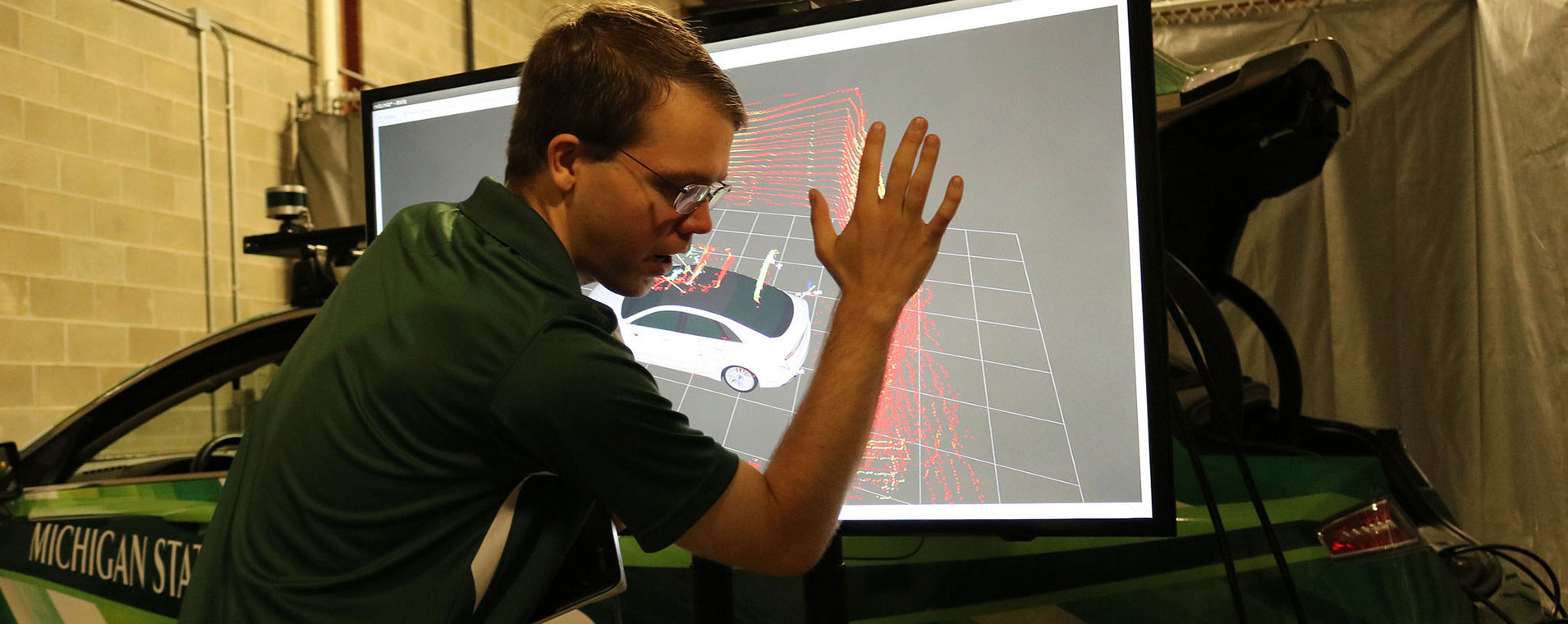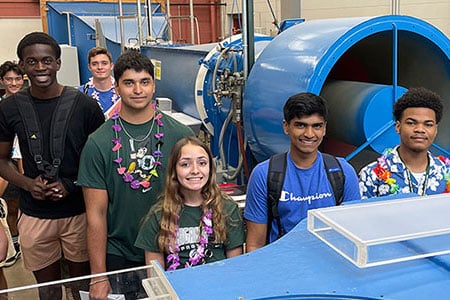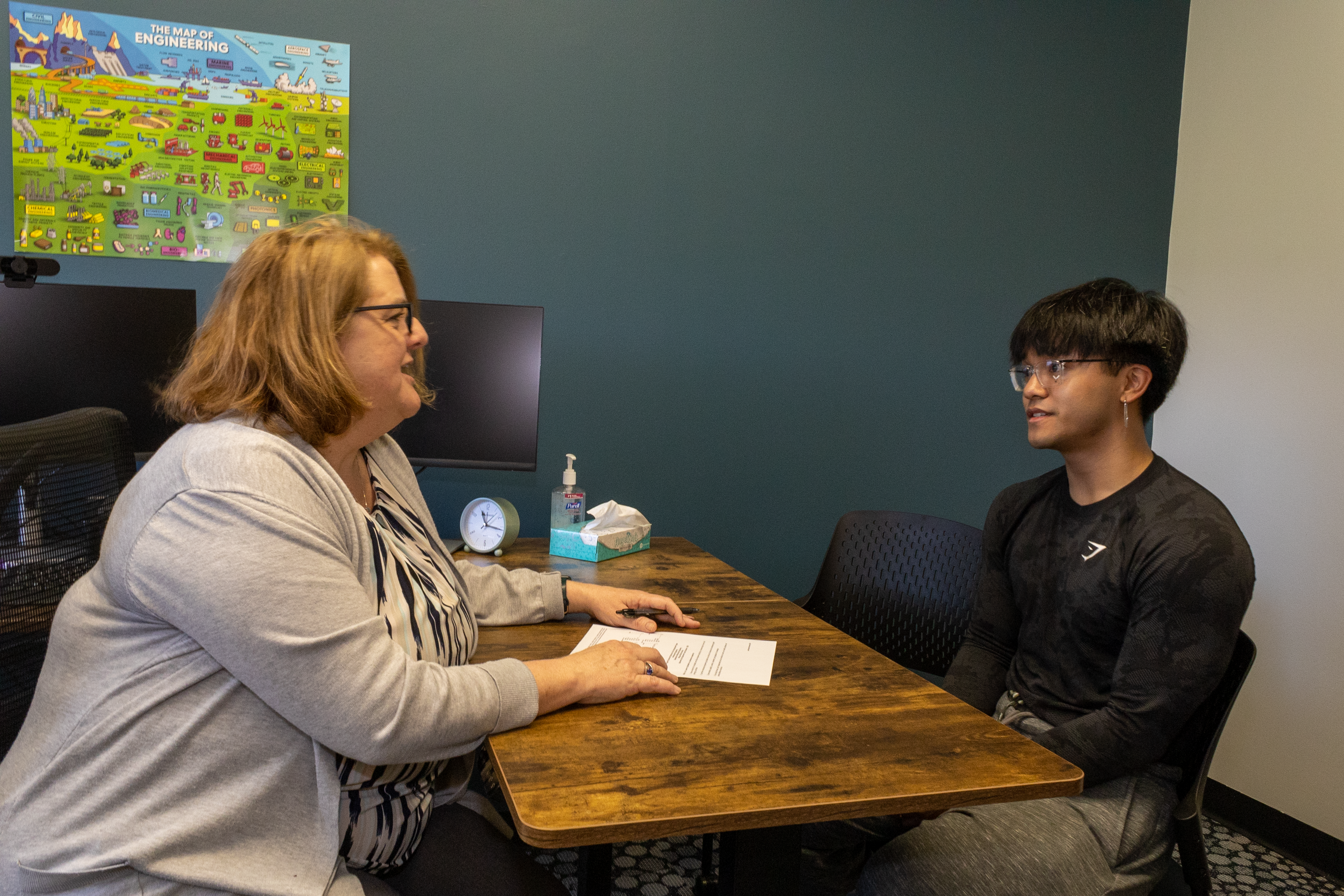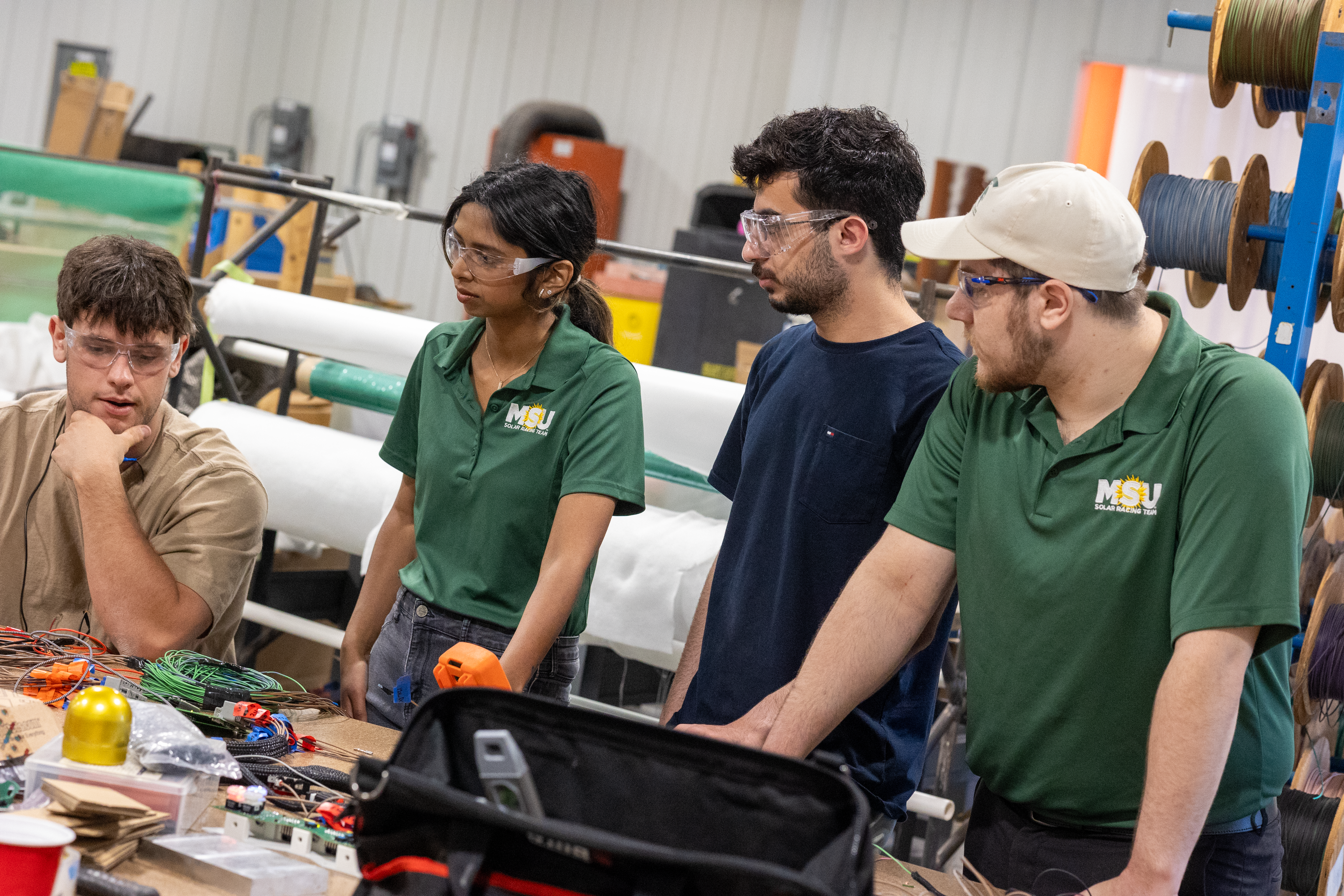
Research Groups
Our faculty are actively engaged in electromagnetics, materials and devices, microelectronics, computing, robotics and control, energy and power systems, signal processing and communications. Students master their interests through classroom instruction, laboratory research, industrial internship experiences, international exchange programs, and project teaming. Design and hands-on labs and courses broaden their educational experience. ECE also has expanded research expertise in nanoscale technologies, advanced microsystems, ubiquitous communications, biological and biomedical engineering, signal processing, autonomous vehicles and robotics, and efficient energy production, transmission, and conversion.
Description
The introduction of wireless networks and its handling of user mobility is perhaps one of the most significant developments of recent years in the rapidly converging areas of pervasive computing and telecommunications. With the introduction of 3G/4G mobile systems, self-organizing sensor and ad hoc networks and the ubiquitous nature of IP connectivity, the technology of mobile networking is likely to be a major growth area in the coming years. In recognition of the importance of this area, the Electrical and Computer Engineering Department of Michigan State University has established a research program in which the students specializing in Computer Networks area are trained on theoretical as well as practical aspects of the technology of computer networks.
Graduate program coursework at the M.S. and Ph.D. levels is taken in both the Electrical and Computer Engineering (ECE) and Computer Science (CSE) Departments. Courses focus on advanced computer networks, mobile network protocols and systems, wireless communication, network security, embedded systems and on advanced algorithms for network protocol design.
Networking research in the ECE Department is structured around three overlapping themes: protocol design, hardware-software development and interdisciplinary network applications. Current research opportunities on wireless protocol research include energy-aware Medium Access Control (MAC) and routing for embedded sensor and Ad Hoc networks, traffic analysis based security mechanisms, multimedia and QoS support, self-organizing MAC, and cross-layer architectures. Research on protocol development deals with self-reorganizing hardware and embedded software design for adaptive network protocols. Challenging research problems exists in this area in the context of energy-constrained embedded applications such as wireless sensor networks. Another area is the design of cryptographic algorithms and network security protocols for the next generation internet, ad-hoc and sensor networks. On a more applied front, significant opportunities exist on a number of ongoing projects on developing interdisciplinary applications. These projects include Vehicle-to-Vehicle networking for Intelligent Transportation Systems (ITS), Wireless Sensor Networks for Environmental Monitoring and Networked Systems for Intrusion and Failure Detection of Large Linear Structures.
Courses and Labs
- ECE 442: Communication Networks (3 credits, Lecture)
- ECE 885: Artificial Neural Networks (3 credits, Lecture)
- ECE 920: High Performance Computing Systems (3 credits, Lecture)
Computer Networking Researchers
Related Websites
Description
Computer engineering (CpE) is a bridge between Electrical Engineering and Computer Science that links hardware implementation (devices, circuits, VLSI) with system (computer architecture, networks) and software (compilers, operating systems) applications. Working jointly, the Electrical and Computer Engineering (ECE) and Computer Science and Engineering (CSE) Departments offer an undergraduate degree in CpE. Students specializing in CpE at Michigan State University will acquire the broad background necessary to contribute effectively to the design and implementation of electronic systems and computer-embedded systems that meet functional, cost, power, performance, and reliability requirements. Undergraduate coursework taken in both the ECE and CSE Departments covers computer architecture, VLSI design, computer/communication networks, operating systems, analog and RF electronics and many advanced topics that are continuously updated to meet the needs of this rapidly evolving filed.
Graduate program coursework at the M.S. and Ph.D. levels is offered by both the ECE and CSE Departments. Courses focus on advanced computer architecture, digital electronic circuits and VLSI design, design and testing of system-on-a-chip and application-specific integrated circuits, contemporary computer-aided design tools and methodologies, embedded systems, hardware/software co-design, algorithms, compilers, operating systems, networks and network security, parallel computing, and other specialized courses.
Researchers in this area investigate a broad range of topics that span the CpE field. Work in computer architecture investigates crosscutting architectural issues arising from interactions with the underlying hardware, software, and network. Research in networking covers mobile network protocols and systems, wireless communication, and network security. Work in microelectronics explores the development of sensor-based microsystems, high performance mixed-signal integrated circuits, and biomedical devices and systems. Research contributions may be in the form of new theories, novel design methods backed by simulation, innovative circuits and microsystems, or the creation of computational artifacts (modeling, simulation tools, software environments, etc.).
Courses and Labs
- ECE 331: Microprocessors and Digital Systems (4 credits, Lecture and Lab)
- ECE 402 Applied Analog Integrated Circuits (4 credits, Lecture and Lab)
- ECE 410: VLSI Design (4 credits, Lecture and Lab)
- ECE 411: Electronic Design Automation (4 credits, Lecture and Lab)
- ECE 412: Mixed Signal Circuit Design (4 credits, Lecture and Lab)
- ECE 813: Advanced VLSI Design (3 credits, Lecture)
- ECE 820: Advanced Computer Architecture (3 credits, Lecture)
- CSE 420: Computer Architecture (3 credits, Lecture)
Faculty
- Subir Biswas
- Erik Goodman
- Nihar Mahapatra
- Andrew Mason
- Jian Ren
- Fathi Salem
- Gregory Wierzba
- Mi Zhang
Related Websites
- Advanced MicroSystems and Circuits Research Group (Mason)
- Advanced Circuits, Architecture, and Computing (Mahapatra)
- Circuits, Systems and Artificial Neural Networks (Salem)
- Genetic Algorithms Research and Applications Group (GARAGe - Goodman)
- Networked Embedded and Wireless Systems (NEEWS - Biswas)
- Cyber Security (Ren)
Description
Biomedical engineering applies the design and problem-solving skills of engineering to the medical field to improve health care and quality of life for individuals. Research and graduate education areas in the Electrical and Computer Engineering department include signal processing applied to cardiovascular, neural system, speech and brain signals; micro-electro-mechanical systems (MEMS) applications to neural implants, biosensors, and long-term implants; and ultrasonics and electromagnetics for thermal therapy and medical imaging.
Courses and Labs
- ECE 445: Biomedical Instrumentation (3 credits, Lecture and Lab)
- ECE 447: Introduction to Biomedical Imaging (3 credits, Lecture)
- ECE 802: Medical Imaging (3 credits, Lecture)
Instructors
- Selin Aviyente
- Subir Biswas
- Wen Li
- Andrew Mason
- Robert McGough
- Rama Mukkamala
- Erin Purcell
- Lalita Udpa
- Satish Udpa
- Sangmin Yoo
Related Websites
- Signal Processing for Studying Functional Networks in the Brain (Aviyente)
- Biomedical micro-electro-mechanical systems (Li)
- Statistical Signal Processing with Application to Speech and Hearing, and Genomics (Deller)
- Nondestructive Evaluation of Biomedical Systems (Udpa)
- Advanced MicroSystems and Circuits (Mason)
- Wireless Body Area Networks, Network Integrated Wireless Sensing, and Biomedical Embedded Integration (Biswas)
Description
Electromagnetics (EM) embody the laws of electrodynamics and constitute the fundamental underlying physics of electrical, electronic, communication, computer, optical, biological, and geophysical technologies. Graduate students and faculty in the electromagnetics area seek to solve a range of practical problems in a wide range of applications.
Graduate students plan their M.S. and Ph.D. programs by choosing a range of comprehensive course offerings and research. Fundamental concepts are treated in Master's level courses while more specialized courses supplement the research program. The facilities available and, more importantly, the research being pursued, are intended to train students to perform cutting edge research in university, government, and industrial settings.
Applied electromagnetics research at MSU comes in three flavors: (I) analytical, (ii) experimental, and (iii) computational. Faculty at MSU have cross-expertise in these areas and typically work in concert with each other to solve specific problems. The research covers a large frequency range, from statics to millimeter and terahertz waves.
In experimental research, students and faculty are currently developing smart antennas that respond to changing signals, developing methods for material characterization, designing novel radar systems and radar sensing applications and RF antennas for breast cancer therapy, and developing non-destructive evaluation techniques. In addition, MSU is renowned for its research in microwave plasma applications.
In the computational area, research is being carried out to develop rigorous physics-based “fast” methods with computational cost and memory that scale linearly with the number of unknowns. Researchers are developing fast time and frequency domain integral equation solvers, higher order finite element methods, meshless methods, hybrid circuit simulators, and multi-physics solvers. These tools are being applied to problems that range from nanophotonics to molecular dynamics, surface enhanced Raman sensors, nanostructure growth, RCS computations, design of conformal antennas, design of materials, and characterization for high-speed circuit analysis.
Courses and Labs
- ECE 305: Electromagnetic Fields and Waves I (4 credits, Lecture)
- ECE 404: Radio Frequency Electronic Circuits (3 credits, Lecture)
- ECE 405: Electromagnetic Fields and Waves II (4 credits, Lecture and Lab)
- ECE 407: Electromagnetic Compatibility (4 credits, Lecture and Lab)
- ECE 835: Electromagnetic Fields and Waves I (3 credits, Lecture)
- ECE 836: Electromagnetic Fields and Waves II (3 credits, Lecture)
- ECE 837: Computational Methods in Electromagnetics (3 credits, Lecture)
- ECE 850: Electrodynamics of Plasmas (3 credits, Lecture)
- ECE 929A: Microwave and Millimeter Wave Circuits (being converted from and ECE 802: Special Topics course) (3 credits, Lecture)
- ECE 929B: Antenna Theory (3 credits, Lecture) ECE 929C: Geometrical Theory of Diffraction (3 credits, Lecture)
- ECE 929D: Fast Computational Methods in Electromagnetics and Acoustics (3 credits, Lecture)
- ECE 989: Advanced Topics in Plasma (3 credits, Lecture)
Faculty
- Jes Asmussen
- Shanker Balasubramaniam
- Sergey Baryshev
- Prem Chahal
- Sunil Chakrapani
- Yiming Deng
- Ming Han
- Leo Kempel
- John Luginsland
- Jeffrey Nanzer
- John Papapolymerou
- Edward Rothwell
- Lalita Udpa
- Satish Udpa
- Cagri Ulusoy
- John Verboncoeur
- Peng Zhang
Description
The work in the power area involves courses and research on power systems, electrical machines and drives. Rapid advances in semiconductor and computing technology and the demand for higher efficiency and better control has led to the integration of power semiconductors into loads (for example: motor drives, process and illumination controllers). Work on electrical drive systems involves the design of new electrical machines tuned to the application, the development of new control methodologies to improve the response of a motor while using fewer sensors, and innovation in power electronics to reduce losses and improve response. Applications range from the automotive and aerospace industries to manufacturing and appliances. This power electronics technology is also being used to help control and stabilize the power system needed if the nations electric utility industry is to maintain our current level of reliability after deregulation is complete.
The power research and teaching laboratories allow the students and researchers to experiment with computer controlled electrical machines, drives, and power electronics systems. The faculty members are actively pursuing research that addresses the problems associated with developing improved motors, power electronic drives, and converters. Current research opportunities in each of these three areas are listed as follows:
- Solution of electromagnetic fields in machines and transformers
- Power electronics in motors and power systems
- Motor drives and controllers
- Special purpose machines
- Intelligent control of power systems
- Power electronics for hybrid electric vehicles
- Power conversion systems for alternative energy
Courses and Labs
- ECE 320: Energy Conversion and Power Electronics (3 credits, Lecture)
- ECE 420: Power Laboratory (1 credit, Lab)
- ECE 423: Power System Analysis (3 credits, Lecture)
- ECE 425: Solid State Power Conversion (3 credits, Lecture)
- ECE 802: Modeling and Control of Power Electronics (3 credits, Lecture)
- ECE 802: Power System Analysis (3 credits, Lecture)
- ECE 821: Advanced Power Electronics and Applications (3 credits, Lecture)
- ECE 823: Power System Stability and Control (3 credits, Lecture)
- ECE 825: Alternating Current Electric Machines and Drives (3 credits, Lecture)
- ECE 924: Power Electronic Systems (3 credits, Lecture)
Power Researchers
- Shanelle Foster
- Woongkul Lee
- Joydeep Mitra
- Elias Strangas
- Bingsen Wang
Related Websites
- Electric Machines and Power Electronics Research (EMPowER) Laboratory (Shanelle Foster, Woongkul Lee, Elias Strangas, Bingsen Wang)
- ERISE (Energy Reliability and Security) (Joydeep Mitra)
Description
We are working toward a scalable evolutionary synthesis system using genetic programming. We hope to deal with systems such as electric circuits or mechatronic systems with hundreds or even thousands of components. However, current evolutionary algorithms (EAs) suffer from lack of scalability. An ideal evolutionary system is characterized with three desirable attributes: Scalability (Larger-size problems can be solved when given more computing resources), Sustainability (Better innovative solutions can be continuously discovered given more computing efforts), and Robustness (reasonable results can be obtained with high probability given a certain amount of computing cycles).
The lack of sustainable search capability of traditional genetic programming (GP) and its tendency to suffer from premature convergence come from two fundamental sources. One is the convergent nature of conventional EA models. The other is the variable length representation and conventional crossover and mutation operators, which cause the bloating phenomenon. Hierarchical Fair Competition (HFC) is a new evolutionary computation model we devised to handle the premature convergence source in term of the EA model itself.
When compared with the natural process of evolution, which does not normally face the issues of stagnation, bloating and lack of sustainability, two significant differences can be observed. One is that, in natural evolution, an enormous population size is typically involved, while we can only use much smaller population sizes in artificial evolution. Another major difference is that in biological evolution, evolution happens at all fitness levels, from the primitive single-cell organism to high-level mammals. This kind of simultaneous multi-level (often corresponding to fitness level) evolution in a multitude of diverse environments may contribute to the sustainability of the biological process. A similar sustainable innovation also happens in human society, in such settings as education systems. By educating students at all academic levels simultaneously and continuously, better and better students are trained to achieve increasing success. Although the population of students at one instant of time is of finite size, the unlimited timeframe and the continual importing of new students from kindergarten provide a non-depletable source for continuing innovation in the school system. In contrast, conventional GA/GP effectively terminate lower-level innovation early, as the average fitness of the population increases. That is, the probability that good building blocks contained in new randomly generated individuals become incorporated in higher-fitness individuals declines rapidly as the average fitness of the population increases.
Courses and Labs
- ECE 802: Evolutionary Multi-Criterion Optimization and Decision-Making (3 credits, Lecture)
- ECE 848: Evolutionary Computing (3 credits, Lecture)
- CSE 801: Introduction to Computational Science for Evolutionary Biologists (3 credits, Lecture)
- CSE 845: Multi-disciplinary Research Methods for the Study of Evolution (3 credits, Lecture)
- CSE 941: Selected Topics in Artificial Intelligence (3 credits, Lecture)
Faculty
- Erik Goodman
- William F. Punch
- Ronald C. Averill
- Xiaobo Tan
- Subir Biswas
- Charles Ofria
- Philip K. McKinley
- Betty Cheng
- Kalyanmoy Deb
Description
Much of the infrastructure that has facilitated the remarkable advances in electronic and computer technology has been based on advances in electronic materials and devices. Research at Michigan State University in electronic materials and devices includes simulation, design, fabrication, characterization, and applications. State of the art facilities have been established for materials synthesis using physical vapor deposition techniques such as e-beam deposition, sputtering, pulsed laser deposition as well as bulk material synthesis such as solid solutions, powder processing and pulsed electric current sintering. In addition, the group is well recognized for their work in microwave assisted plasma chemical vapor deposition and its use in the growth of single crystalline, polycrystalline and nanocrystalline diamond, diamond like carbon, amorphous carbon, and carbon nanotubes, as well as a variety of carbide and nitride hard coating techniques which utilize microwave and plasma technologies developed in this group. Facilities in the department include semiconductor characterization equipment, and a class 1000 cleanroom for standard lithography processes used in device fabrication and microelectromechanical system (MEMS) development.
Additional research includes the investigation of electronic/structural properties and biocompatibility of nanostructures, the growth mechanisms of carbon nanostructures, amorphous tetrahedral carbon, diamond, nanowires, scanning probe microscopy and nanomanipulation. Synthesis, fabrication and characterization studies of thermoelectric materials. The design, growth, and investigation of compound semiconductors for device applications using in-situ monitoring is coupled with statistical analysis and advanced modeling techniques.
Instructors
- John Albrecht
- Dean Aslam
- Jes Asmussen
- Virginia Ayres
- Qi Hua Fan
- Timothy Grotjohn
- Tim Hogan
- Wen Li
- Aljoscha Roch
- Thomas Schuelke
- Nelson Sepulveda
- Chuan Wang
- Tom Zimmermann
Courses and Labs
- ECE 474: Principles of Electronic Devices (3 credits, Lecture)
- ECE 476: Electro-Optics (4 credits, Lecture and Lab)
- ECE 477: Microelectronic Fabrication (3 credits, Lecture and Lab)
- ECE 870: Introduction to Micro-Electro-Mechanical Systems (3 credits, Lecture)
- ECE 871: Microsystems Fabrication (3 credits, Lecture)
- ECE 874: Physical Electronics (3 credits, Lecture)
- ECE 875: Electronic Devices (3 credits, Lecture)
- ECE 877: Cleanroom Procedures (3 credits, Lecture and Lab)
- ECE 931C: Properties of Semiconductors (3 credits, Lecture)
Related Websites
Description
Integrated microsystems refer to miniaturized (portable, handheld, implantable) electronic systems containing sensors, actuators, and sophisticated circuits that provide intelligent control and communication. It is an interdisciplinary field that is based in microelectronics but spans the technology and applications of many areas of science, engineering and medicine. Engineers in this field engage in research and development of analog and digital integrated circuits, RF circuits and wireless systems, microfabricated sensors and actuators, microelectronics packaging, and microfluidics. In this age of portable electronics, the theoretical and practical elements of the integrated microsystem field are increasingly important in a variety of applications including medical devices, environmental monitoring, energy scavenging, embedded systems and sensor networks. Students interested in this field will gain significant experience with the techniques and tools of integrated microsystems through courses covering mixed-signal integrated circuits, microelectronic materials and devices, microfabrication, and sensor instrumentation.
Graduate coursework at the M.S. and Ph.D. levels is centered in the Electrical and Computer Engineering (ECE) Department but may incorporate a variety of courses in science and engineering to provide the necessary background for specific integrated microsystems. Core courses in ECE focus on solid-state devices, micro-electro-mechanical systems (MEMS), analog and RF integrated circuits, VLSI design tools and methodologies, system-on-chip design and packaging, nanotechnologies, and biomedical microsystems.
Faculty and student researchers at MSU explore a wide range of technologies and applications associated with integrated microsystems. Current projects include modeling of smart materials, ultra-low-power electronics, energy harvesting circuits, biosensor array systems, bioelectrochemical sensors, wireless sensors, biomimetic devices and systems, lab-on-chip systems, and implantable microsystems. Research in the integrated microsystems area is often done in collaboration with scientists, engineers, and medical professionals to form investigative teams with the diverse expertise needed to address multi-disciplinary challenges.
Courses and Labs
- ECE 404: RF Electronics (4 credits, Lecture and Lab)
- ECE 410: VLSI Design (4 credits, Lecture and Lab)
- ECE 412: Mixed Signal Circuit Design (4 credits, Lecture and Lab)
- ECE 813: Advanced VLSI Design (3 credits, Lecture) ECE 870: Introduction to Micro-Electro-Mechanical Systems (3 credits, Lecture)
- ECE 871: Microsystems Fabrication (3 credits, Lecture)
Micro and Nano Electronics and VLSI Researchers
- Dean Aslam
- Prem Chahal
- Lixin Dong
- Wen Li
- Andrew Mason
- John Papapolymerou
- Fathi Salem
- Xiaobo Tan
- Cagri Ulusoy
- Sangmin Yoo
Related Websites
Description
Robotics and control are two closely related fields, both of which have a rich heritage of intellectual depth and practical achievements. The Robotics and Control area group offers an array of undergraduate and graduate courses in control, robotics, and automation, and conducts vibrant research at the frontier of these fields. For example, in robotics research, faculty research interests span underwater robotics, aerial robotics, autonomous vehicles, and soft robotics; and in controls, faculty research interests include distributed and networked control, learning-based control, game theory, and cyber-physical-human systems. These research activities are often motivated by and evaluated in real-world applications, such as tracking invasive species, autonomous driving, resilience in cyber-physical systems, and underwater search and rescue. Some highlights of faculty research are provided below.
Bio-inspired Robotics (Tan): Taking inspiration from nature, we develop novel robots and explore their applications in environmental monitoring, healthcare, and search-and-rescue. Our work emphasizes fundamental research while keeping in sight their practical relevance, with an end-to-end cycle of robot design, dynamic modeling, control, and experimentation (often involving field experiments). Examples of our robots include gliding robotic fish for underwater sensing, snake robots for pipeline inspection, and soft robotic gloves for studying motor learning. We are also interested in new smart materials and their application to sensing and actuation.
3D Vision (Morris): We explore the world of 3D sensing using machine learning and artificial intelligence. For example, automated vehicles generate gigabits of data per second. Making sense of this and turning it into useful knowledge can be hard. Our work creates new algorithms for sensor processing (especially Lidar and video) to enable scene modeling and understanding. We are also interested in the application of 3D vision to smart agriculture (e.g., animal detection and tracking, plant photosynthesis distribution assessment) and tremor tracking for Parkinson’s disease patients.
Distributed Cyber Physical Human Systems (Srivastava): Our work focuses on Cyber-Physical-Human Systems (CPHS), which involve several agents, such as humans and robots, interacting over a network to achieve a desired outcome. The goal of our research is the realization of synergistic collaboration of autonomous systems with human partners towards desired goals. To this end, we use control-theoretic techniques towards agent modeling, including cognitive modeling of human agents, as well as analysis and design of shared human-robot multi-agent systems. These efforts often build upon techniques from stochastic optimal control, nonlinear control, and network systems. Our experimental facilities include ground and aerial robotics arena, an open-source swarm testbed, EEG and eye-tracking facilitated human-robot teaming, and haptic tele-operation.
Safe and Resilient Learning-enabled Control (Kiumarsi): The goal is to combine learning, optimization, and safe control, to enable next-generation autonomous systems. In safe learning-enabled control, we aim to integrate performance-oriented control objectives with safety specifications and monitor the system’s learning process to proactively trade-off between safety and performance. In resilient learning-enabled control, we aim to bridge the gap between reinforcement learning-based control design and resilient control design for cyber-physical systems under uncertainty and possible malicious activities.
Secure and Efficient Autonomous Systems (Bopardikar): Our group performs fundamental research in efficient and effective motion planning of autonomous vehicles to achieve complex objectives while guaranteeing security against adversarial attacks. The research topics span multiple disciplines ranging from control theory, game theory, estimation and randomized algorithms. Applications include integrity of current and future autonomous systems (e.g., self-driving cars), environmental monitoring and estimation with limited resources.
Physical Ultrasonics, Microscopy and Acoustics (Chakrapani). Our research focuses on 2D, 3D and 4D imaging of structures for flaws/defects using acoustics/ultrasonics, acoustic microscopy and studying the interaction of ultrasonics waves with discontinuities. 2D imaging allows us to determine the location of the discontinuity, 3D imaging allows us to determine the depth, and 4D imaging allows us to determine the evolution with time. Unlike optical imaging which only provides location, elastic imaging allows us to image the stiffness of the structure as well. We use non-contact, non-invasive methods to develop complete 3D models, and digital twins of the structure. Applications include structural elements such as bridges, pavements; aerospace components such as jet engine, rotor blades etc.; biomedical applications such as tissue; and material characterization.
Courses and Labs
- ECE 313: Control Systems (3 credits, Lecture)
- ECE 415: Computer Aided Manufacturing (3 credits, Lecture and Lab)
- ECE 416: Digital Control (3 credits, Lecture and Lab)
- ECE 417: Robotics (4 credits, Lecture and Lab) ECE 818: Robotics (3 credits, Lecture)
- ECE 819: Smart Material Sensors and Actuators (3 credits, Lecture)
- ECE 851: Linear Systems and Control (3 credits, Lecture)
- ECE 853: Optimal Control (3 credits, Lecture)
- ECE 854: Robust Control (3 credits, Lecture) ECE 856: Adaptive Control (3 credits, Lecture)
- ECE 859: Nonlinear Systems and Control (3 credits, Lecture)
- ECE 960C: Networked and Embedded Control Systems (3 credits, Lecture)
Instructors
Related Websites
- Secure and Efficient Autonomous Systems Lab (Bopardikar)
- Physical Ultrasonics, Microscopy and Acoustics (PUMA) Lab (Chakrapani)
- Learning-enabled Control (Kiumarsi)
- 3D Vision Lab (Morris)
- Distributed CYber Physical Human systEms Research (D-CYPHER) Lab (Srivastava)
- Open Swarm
- Smart Microsystems Lab (Tan)
Description
The Communications and Signal Processing (CSP) group in the ECE department is engaged in a broad range of fundamental and applied research areas. Examples of fundamental research areas include:
- Statistical communications
- Statistical signal processing
- System identification and adaptive filtering
- Time-frequency analysis
- Multidimensional signal processing
- Information theory and coding
In addition to making theoretical contributions in these areas, the CSP group is engaged in emerging and traditional CSP applications. In particular, CSP faculty members are active in several applied research areas including:
- Wireless communications and networking
- Speech processing and voice recognition
- Visual processing and multimedia networking
- Biomedical signal processing
- Non-destructive-evaluation (NDE)
- Sensor networks and compressed sensing
- Secure communications and network security
Being leaders in their respective fields of research, CSP faculty research is supported by federal agencies, such as NSF and NIH, state technology programs and industrial partners. Both national and international collaborative efforts are pursued. CSP faculty members collaborate with faculty members of other ECE areas and other colleges within and outside MSU on multidisciplinary research projects.
Courses and Labs
- ECE 366: Introduction to Signal Processing (3 credits, Lecture)
- ECE 457: Communication Systems (3 credits, Lecture)
- ECE 458: Communication Systems Laboratory (1 credit, Lab)
- ECE 466: Digital Signal Processing and Filter Design (3 credits, Lecture)
- ECE 816: Cryptography and Network Security (3 credits, Lecture)
- ECE 864: Detection and Estimation Theory (3 credits, Lecture)
Instructors
- Selin Aviyente
- John Deller
- Tongtong Li
- Rama Mukkamala
- Erin Purcell
- Hayder Radha
- Lalita Udpa
- Satish Udpa
Related Websites
- Wireless and Video Communications (Radha WAVES)
- Statistical Signal Processing Theory and Applications including Studying Functional Networks in the Brain (Aviyente)
- Statistical Signal Processing with Application to Speech and Hearing, and Genomics (Deller)
- Nondestructive Evaluation of Biomedical Systems (Udpa's)
- Broadband Access Wireless Communications Laboratory (Li)





